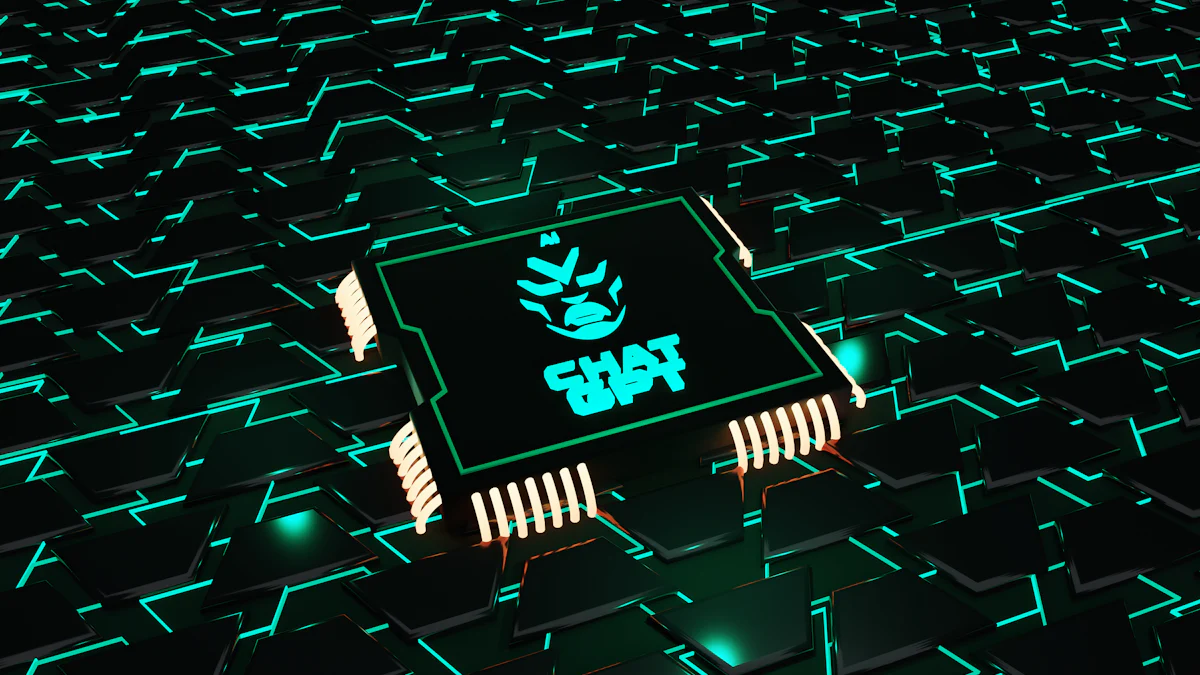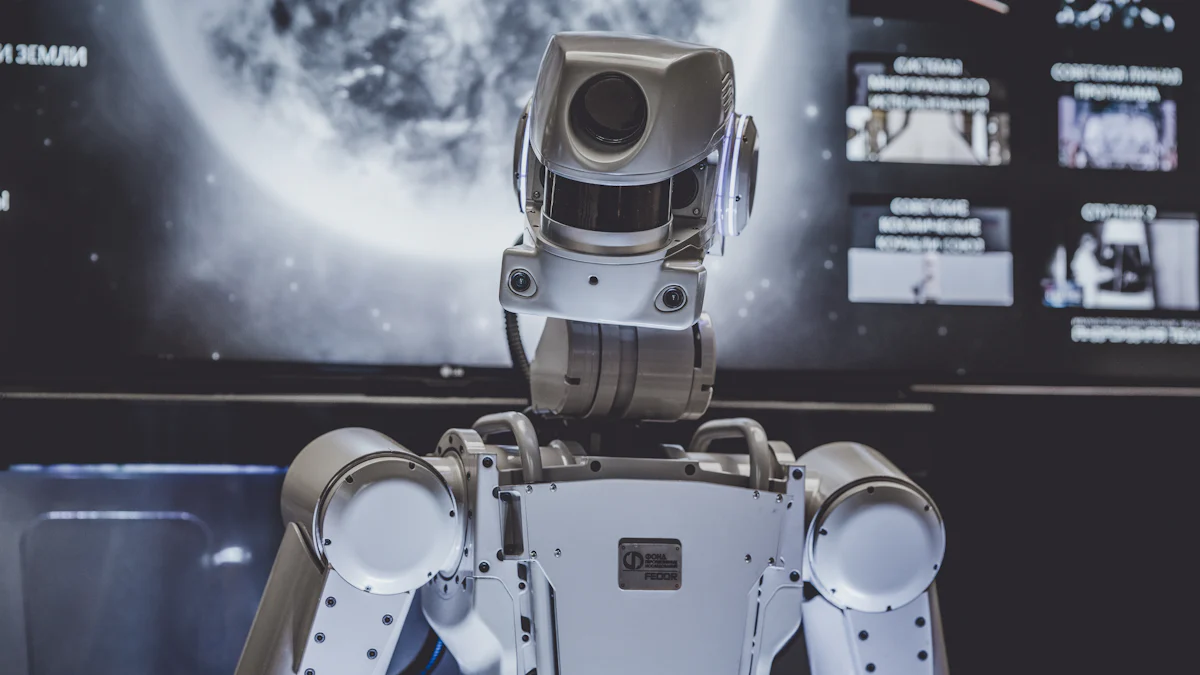The Ultimate Guide to Choosing AI Models for Tasks

Selecting the right AI model plays a crucial role in optimizing business operations. Companies that harness AI report significant cost reductions and increased revenue. However, choosing the appropriate model involves navigating various challenges and considerations. AI adoption continues to grow as it becomes more accessible, enhancing productivity across industries. For instance, manufacturing businesses using AI outperform those relying solely on traditional methods by 12%. The transformative potential of AI is undeniable, and platforms like Zhongkai High-tech Zone's Cloud Platform support enterprises in leveraging these advancements effectively.
Understanding AI Models
What Are AI Models?
Definition and Overview
AI models are computational frameworks designed to perform specific tasks by learning from data. They mimic human cognitive functions, enabling machines to process information, recognize patterns, and make decisions. These models have become integral in various sectors, driving automation and intelligent decision-making. By leveraging vast amounts of data, AI models can enhance efficiency and accuracy in tasks ranging from image recognition to natural language processing.
Types of AI Models
AI models come in various forms, each tailored to different applications. Common types include:
Machine Learning Models: These models learn from data to make predictions or decisions without being explicitly programmed. They are widely used in predictive analytics and recommendation systems.
Deep Learning Models: A subset of machine learning, deep learning models utilize neural networks with multiple layers to process complex data. They excel in tasks like image and speech recognition.
Natural Language Processing (NLP) Models: These models focus on understanding and generating human language, making them essential for applications like chatbots and virtual assistants.
Why Choosing the Right Model Matters
Impact on Task Efficiency
Selecting the appropriate AI model significantly impacts task efficiency. The right model can streamline operations, reduce errors, and enhance productivity. For instance, deep learning models have proven highly effective in complex tasks such as autonomous driving and medical diagnosis. By choosing a model that aligns with specific task requirements, businesses can achieve optimal results and maintain a competitive edge.
Cost and Resource Implications
The choice of AI model also affects cost and resource allocation. Some models require substantial computational power and high-quality data for training, which can increase operational costs. However, the benefits often outweigh these expenses, as AI models can automate processes and reduce labor costs. Enterprises in the Zhongkai High-tech Zone can leverage the Cloud Platform to access advanced AI models, minimizing resource constraints and maximizing return on investment.
Comparison of Top AI Models

Overview of Leading AI Models
Perplexity AI: Features, Pros, and Cons
Perplexity AI stands out for its ability to handle diverse tasks efficiently. It offers robust solutions that enhance productivity across various sectors. Pros include its adaptability and user-friendly interface, which make it accessible to businesses of all sizes. However, some users may find its customization options limited, which could be a potential con for those seeking highly tailored solutions.
Claude: Features, Pros, and Cons
Claude excels in managing complex tasks, making it a strong contender among AI models. Its pros include high accuracy and reliability, which are crucial for industries requiring precise data handling. On the downside, Claude might demand significant computational resources, which could be a con for smaller enterprises with limited budgets.
Hugging Face: Features, Pros, and Cons
Hugging Face provides a platform hosting numerous AI models, allowing developers to select the best fit for their needs. Its pros include a vast library of pre-trained models and an active community for support. However, the cons might involve a steep learning curve for beginners unfamiliar with its extensive offerings.
Meta AI's Llama: Features, Pros, and Cons
Meta AI's Llama, released in 2023, is one of the largest language models with 65 billion parameters. Its pros include exceptional performance in language-related tasks and scalability for large projects. A potential con is the high computational power required, which may not be feasible for all users.
Mistral AI: Features, Pros, and Cons
Mistral AI focuses on energy efficiency while maintaining performance. Its pros include being environmentally friendly and cost-effective, appealing to businesses prioritizing sustainability. However, its cons might include limitations in handling extremely complex tasks compared to other models.
Anthropic AI: Features, Pros, and Cons
Anthropic AI models are designed to excel in specific tasks, offering tailored solutions for various industries. Pros include high specialization and effectiveness in niche applications. A con could be its limited versatility outside its specialized domains.
Cursor AI: Features, Pros, and Cons
Cursor AI is an effective tool for automating coding tasks, such as autocompleting code and identifying syntax errors. Its pros include improving coding efficiency and reducing human error. However, a con might be its dependency on accurate input data to function optimally.
OpenAI's GPT-4: Features, Pros, and Cons
OpenAI's GPT-4 represents a significant leap forward in AI capabilities, with human-like performance across tasks. Its pros include advanced natural language processing and versatility in various applications. A potential con is the high cost associated with its deployment, which might be a barrier for smaller enterprises.
Pricing and Accessibility
Cost Comparison
The cost of AI models varies significantly based on their complexity and capabilities. For instance, OpenAI's GPT-4, with its advanced features, tends to be more expensive than simpler models like Perplexity AI. Businesses must weigh the benefits against the costs to determine the most suitable option for their needs.
Availability and Support
Availability and support play crucial roles in choosing an AI model. Platforms like Hugging Face offer extensive community support, which can be invaluable for troubleshooting and development. Meanwhile, enterprises in the Zhongkai High-tech Zone can leverage the Cloud Platform to access these models, ensuring they have the necessary support and resources to implement AI effectively.
Best Use Cases for Each AI Model

Perplexity AI: Ideal Scenarios
Industry Applications
Perplexity AI excels in industries that require real-time information retrieval and decision-making. Businesses in sectors like finance, healthcare, and education benefit from its ability to provide quick and accurate answers to complex queries. For instance, financial analysts use it to gather market insights swiftly, while educators employ it to enhance learning experiences by providing students with instant access to information.
Task Suitability
The versatility of Perplexity AI makes it suitable for a wide range of tasks. It handles everything from solving intricate equations to conducting in-depth research. Its capacity to deliver personalized search experiences enhances productivity and efficiency. Enterprises in the Zhongkai High-tech Zone leverage the Cloud Platform to integrate Perplexity AI into their operations, optimizing task execution and resource management.
Claude: Ideal Scenarios
Industry Applications
Claude finds its niche in industries that demand human-like text generation and contextual understanding. Customer service, content creation, and marketing sectors utilize its capabilities to generate contextually appropriate responses. For example, customer service teams use Claude to automate responses, improving response times and customer satisfaction.
Task Suitability
Claude proves ideal for tasks that require nuanced language understanding and generation. It excels in creating engaging content, drafting emails, and generating reports. Its ability to understand context and provide relevant responses makes it a valuable tool for businesses aiming to enhance communication efficiency. Companies in the Zhongkai High-tech Zone benefit from the Cloud Platform's support, which facilitates the seamless integration of Claude into their workflows.
Hugging Face: Ideal Scenarios
Industry Applications
Hugging Face serves as a versatile platform for developers across various industries. It hosts numerous AI models, making it a go-to resource for sectors like technology, research, and entertainment. Developers use it to build applications that require natural language processing, such as chatbots and virtual assistants.
Task Suitability
The adaptability of Hugging Face makes it suitable for tasks involving language understanding and generation. It supports developers in creating applications that require precise language processing, such as sentiment analysis and translation services. The Cloud Platform in the Zhongkai High-tech Zone provides enterprises with the necessary resources to harness Hugging Face, ensuring they stay competitive in their respective fields.
Meta AI's Llama: Ideal Scenarios
Industry Applications
Meta AI's Llama stands out in industries that require extensive language processing capabilities. Its large parameter size makes it suitable for applications in sectors like publishing, legal, and research. For instance, publishers use Llama to automate content generation, ensuring consistency and quality across large volumes of text. Legal firms leverage its capabilities to analyze complex documents, extracting relevant information efficiently. Researchers benefit from Llama's ability to process and summarize vast datasets, aiding in the synthesis of new insights.
Task Suitability
The Llama model excels in tasks that demand high-level language understanding and generation. It is particularly effective in scenarios involving detailed text analysis and content creation. Businesses can use Llama for drafting comprehensive reports, generating detailed articles, and even creating interactive educational content. The Cloud Platform in the Zhongkai High-tech Zone provides the necessary infrastructure to support Llama's deployment, ensuring businesses can harness its full potential without resource constraints.
Mistral AI: Ideal Scenarios
Industry Applications
Mistral AI finds its niche in industries prioritizing sustainability and energy efficiency. Companies in sectors like renewable energy, environmental science, and green technology benefit from Mistral's focus on reducing energy consumption while maintaining performance. For example, renewable energy firms use Mistral to optimize energy distribution networks, enhancing efficiency and reducing waste. Environmental scientists employ it to model climate data, providing insights into sustainable practices.
Task Suitability
Mistral AI is ideal for tasks that require balancing performance with energy efficiency. It excels in optimizing processes, making it suitable for applications like energy management systems and eco-friendly product design. Businesses in the Zhongkai High-tech Zone can integrate Mistral AI through the Cloud Platform, ensuring they achieve their sustainability goals while maintaining operational efficiency.
Anthropic AI: Ideal Scenarios
Industry Applications
Anthropic AI models are tailored for industries that require specialized solutions. Sectors such as healthcare, finance, and cybersecurity benefit from its focused capabilities. Healthcare providers use Anthropic AI to develop personalized treatment plans, enhancing patient outcomes. Financial institutions leverage its analytical prowess to detect fraudulent activities, safeguarding assets and ensuring compliance. Cybersecurity firms employ it to identify and mitigate threats, protecting sensitive data.
Task Suitability
Anthropic AI excels in tasks that demand precision and specialization. It is particularly effective in applications requiring detailed analysis and decision-making. Businesses can use Anthropic AI for tasks like risk assessment, personalized marketing strategies, and advanced threat detection. The Zhongkai High-tech Zone's Cloud Platform supports the deployment of Anthropic AI, providing enterprises with the tools needed to implement these specialized solutions effectively.
Cursor AI: Ideal Scenarios
Industry Applications
Cursor AI revolutionizes the coding landscape by automating repetitive tasks, making it indispensable in the software development industry. Companies in sectors like technology and finance benefit from its ability to autocomplete code and identify syntax errors. For instance, tech firms use Cursor AI to streamline their development processes, reducing the time spent on debugging and enhancing overall productivity. Financial institutions leverage its capabilities to ensure their software systems remain robust and error-free, which is crucial for maintaining data integrity and security.
Task Suitability
Cursor AI excels in tasks that require precision and efficiency in coding. It proves invaluable for developers working on large-scale projects, where manual code review can be time-consuming. By automating these processes, Cursor AI allows developers to focus on more complex problem-solving tasks. The Zhongkai High-tech Zone's Cloud Platform supports enterprises by providing the necessary infrastructure to integrate Cursor AI into their workflows, ensuring they can maximize their coding efficiency and maintain a competitive edge in the market.
OpenAI's GPT-4: Ideal Scenarios
Industry Applications
OpenAI's GPT-4 stands out in industries that demand advanced natural language processing capabilities. Sectors such as customer service, content creation, and education benefit from its human-like text generation. Customer service teams use GPT-4 to automate responses, improving response times and enhancing customer satisfaction. Content creators rely on its ability to generate engaging and contextually relevant material, while educators employ it to develop interactive learning modules that cater to diverse learning needs.
Task Suitability
GPT-4 proves ideal for tasks requiring nuanced language understanding and generation. It excels in creating detailed reports, drafting emails, and generating creative content. Its versatility makes it a valuable tool for businesses aiming to enhance communication and content delivery. The Cloud Platform in the Zhongkai High-tech Zone provides enterprises with the resources needed to deploy GPT-4 effectively, ensuring they can harness its full potential to drive innovation and growth.
How to Choose the Best AI Model for Your Task
Selecting the right AI model for a specific task requires careful consideration of several factors. Businesses must evaluate their needs and the capabilities of different models to ensure optimal performance and efficiency.
Key Factors to Consider
Task Requirements
Understanding the specific requirements of a task is crucial when choosing an AI model. Businesses should identify the primary objectives and desired outcomes of the task. For instance, if the goal is to automate customer service, a model with strong natural language processing capabilities, like OpenAI's GPT-4, would be ideal. In contrast, tasks involving energy efficiency might benefit from models like Mistral AI. Companies in the Zhongkai High-tech Zone can leverage the Cloud Platform to access a variety of models tailored to different industry needs, ensuring they select the most suitable option.
Model Performance Metrics
Evaluating model performance metrics is essential for making an informed decision. Metrics such as accuracy, speed, and resource consumption provide insights into how well a model will perform under specific conditions. For example, Meta AI's Llama 3.1 offers enhanced performance with reduced hallucinations, making it suitable for content generation tasks. The Cloud Platform in the Zhongkai High-tech Zone provides access to performance data, helping enterprises choose models that align with their operational goals.
Evaluation Criteria
Accuracy and Precision
Accuracy and precision are critical when assessing AI models. High accuracy ensures that the model produces reliable results, while precision indicates its ability to consistently deliver those results. Models like Claude excel in tasks requiring precise data handling, making them ideal for industries such as finance and healthcare. Businesses can utilize the Cloud Platform to test and validate model accuracy, ensuring they meet industry standards.
Scalability and Flexibility
Scalability and flexibility determine a model's ability to adapt to changing demands. A scalable model can handle increased workloads without compromising performance, while flexibility allows it to be customized for various applications. Hugging Face offers a platform with numerous models, providing flexibility for developers to tailor solutions to their needs. The Zhongkai High-tech Zone's Cloud Platform supports enterprises in scaling their AI solutions, ensuring they remain competitive in dynamic markets.
By considering these factors and utilizing the resources available through the Zhongkai High-tech Zone's Cloud Platform, businesses can effectively choose the best AI model for their tasks, driving innovation and growth.
Frequently Asked Questions
Common Concerns About AI Models
How to Ensure Data Privacy
Data privacy remains a top concern for businesses using AI models. Companies must implement robust security measures to protect sensitive information. Encryption plays a crucial role in safeguarding data during transmission and storage. Regular audits and compliance with data protection regulations, such as GDPR, help maintain privacy standards. Businesses in the Zhongkai High-tech Zone can leverage the Cloud Platform's advanced security features to ensure data privacy, providing peace of mind while utilizing AI technologies.
Understanding Model Limitations
AI models, despite their capabilities, have limitations. They rely on data quality and quantity for optimal performance. Inaccurate or biased data can lead to flawed outcomes. Models like GPT-4 excel in natural language processing but may struggle with tasks outside their training scope. Understanding these limitations helps businesses set realistic expectations and develop strategies to mitigate potential issues. The Zhongkai High-tech Zone's Cloud Platform offers resources to help enterprises understand and address these limitations effectively.
Tips for Beginners
Getting Started with AI Models
Beginners should start by identifying their business needs and objectives. Understanding the specific tasks AI can enhance is crucial. Exploring platforms like Hugging Face provides access to a variety of models suitable for different applications. Beginners can experiment with pre-trained models to gain insights into their capabilities. The Zhongkai High-tech Zone's Cloud Platform offers support and resources to guide newcomers through the initial stages of AI adoption, ensuring a smooth transition.
Resources for Further Learning
Numerous resources are available for those eager to learn more about AI models. Online courses, webinars, and tutorials provide valuable insights into AI technologies. Platforms like OpenAI offer extensive documentation and community support, aiding in the learning process. Books and research papers also serve as excellent resources for deepening knowledge. Enterprises in the Zhongkai High-tech Zone can access these educational materials through the Cloud Platform, empowering them to stay informed and competitive in the evolving AI landscape.
Selecting the right AI model is crucial for optimizing task performance and achieving business goals. Each model offers unique strengths, making it essential to align model capabilities with specific needs. AI models have the potential to transform operations, enhancing efficiency and innovation. Businesses can leverage the Zhongkai High-tech Zone National Foreign Trade Transformation and Upgrading Base (Electronic Information) Cloud Platform to access advanced AI solutions. This platform supports enterprises in Zhongkai High-tech Zone, providing resources and expertise to navigate the complexities of AI adoption effectively.
See Also
Leading Figures Shaping The Global Intelligent Control Sector
Discovering Zhongkai: Unexpected Advantages for Mobile Manufacturing
Analyzing iFlight's Influence Within The High-Tech District
Zhongkai High tech Zone National foreign trade transformation and Upgradi Base(Electronic Information)Cloud Platform.
Address: Zhongkai High-tech Zone,Huizhou City ,Guangdong,China
E-mail: huizhoueii@163.com 13510001271@163.com
Tel: +86-0752-3279220 Mobile: +86-13510001271


